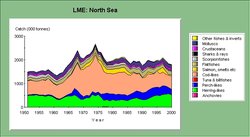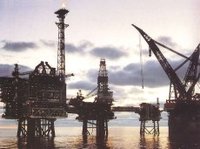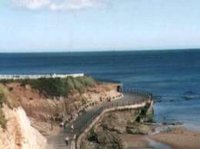North Sea large marine ecosystem
Contents
- 1 Introduction Location of the North Sea Large Marine Ecosystem. (Source: NOAA (North Sea large marine ecosystem) )
- 2 Productivity
- 3 Fish and Fisheries
- 4 Pollution and Ecosystem Health
- 5 Socioeconomic Conditions
- 6 Governance
- 7 Articles and LME VolumesDann, Niels. 1986. "Results of Recent Time-Series Observations for Monitoring Trends in Large Marine Ecosystems with a Focus on the North Sea." In K. Sherman and L.M. Alexander (eds.), Variability and Management of Large Marine Ecosystems, (Boulder: Westview Press) pp. 145-174. ISBN: 0813371457 (North Sea large marine ecosystem) . * Dann, Niels, 1993. Simulation study of effects of closed areas to all fishing, with particular reference to the North Sea ecosystem. In K. Sherman, L.M. Alexander and B.D. Gold (eds), Large Marine Ecosystems—Stress, Mitigation, and sustainability. (AAA Press) pp. 252-258. ISBN: 087168506X. * FAO, 2003. FAO Trends in oceanic captures and clustering of large marine ecosystems—2 studies based on the FAO capture database. FAO fisheries technical paper 435. 71 pages. * McGlade, J.M. 2002. The North Sea Large Marine Ecosystem. In K. Sherman and H.R. Skjoldal, eds. Large Marine Ecosystems of the North Atlantic—Changing states and Sustainability. Forthcoming volume, Elseviers. 339-412.
- 8 Other References
Introduction Location of the North Sea Large Marine Ecosystem. (Source: NOAA (North Sea large marine ecosystem) )
The North Sea Large Marine Ecosystem (LME) is characterized by a temperate climate and four seasons. It is a semi-enclosed sea situated on the continental shelf of Northwestern Europe, in the Atlantic Ocean. It covers an area of 745,950 kilometers (km2) and has a mean depth of 90 meters (m). The North Sea includes one of the most diverse coastal regions in the world, with a great variety of habitats (fjords, estuaries, deltas, banks, beaches, sandbanks and mudflats, marshes, rocks and islands). Intensive fishing is the primary force driving the LME, with climate as the secondary driving force. England, Scotland, Norway, Sweden, Denmark, Germany, the Netherlands, Belgium and France are the 9 countries bordering the North Sea. LME book chapters and articles pertaining to this LME include Dann, 1986, Dann, 1993, and McGlade, 2002.
Productivity
For a map of the LME and its features, see McGlade, 2002, p. 340. There is a wealth of data on the North Sea. For more information on climatology, and physical, chemical and biological oceanography, see McGlade, 2002. The North Sea LME is considered a Class I, highly productive (>300 grams of Carbon per square meter per year), ecosystem based on SeaWiFS global primary productivity estimates. Primary production varies considerably across the North Sea. The highest values of primary productivity occur in the coastal regions, influenced by terrestrial inputs of nutrients, and in areas such as the Dogger Bank and tidal fronts. Changes observed in trophic structure are indicative of a trend towards a decreasing resilience of this ecosystem. This trend is partially a response to inter-annual changes in the physical oceanography of the North Atlantic. For more information on plankton communities, benthic communities and fish and shellfish communities, see McGlade, 2002. For food web dynamics, and information about bird communities and marine mammals, see McGlade, 2002. The Sir Alistar Hardy Foundation reports on results of plankton abundance in the North Sea .
Fish and Fisheries
 LME: North Sea. (Source: NOAA)
LME: North Sea. (Source: NOAA) Fishing is a well-established activity in the North Sea, and there is a wealth of fisheries data. The North Sea is a highly productive LME supporting average landings of 2.5 million metric tons of fish and shellfish every year. The total biomass (adding food for predatory fish species, birds and mammals) is approximately 10 million metric tons. The Food and Agriculture Organization (FAO) 10-year trend shows a decrease from 2.5 million tons in 1990 to 2.3 million tons in 1999 (see FAO, 2003), with several peaks and troughs. The most important species represented are coastal fishes (averaging 33% of the total catch), pelagic fishes (10% of the catch) and herrings, sardines and anchovies (22%). Fish landed include mackerel, cod, haddock, whiting, saithe, plaice and sole. For more information on North Sea fishing fleets, see McGlade, 2002. Landings from the industrial fishery consist mainly of sandeels, Norway pout and sprat. There are several commercially important shellfish species of mulluscs and crustaceans, including shrimp, crab, lobster, oysters, mussels and scallops. The North Sea is not entirely stable with regard to individual species. Changes in the abundance of commercially important fish stocks have been monitored since the 1950s. All are heavily exploited and the majority of those landed for human consumption are considered to be in a seriously depleted condition. Analytical assessments (Environmental Impact Assessment) of all commercially important species are carried out by the International Council for the Exploration of the Seas (ICES). Improvements in fishing equipment (more powerful engines, hydroacoustic equipment, and the purse-seine net in the mid 1960s) have changed the nature of the fisheries. Various fishing restrictions (closures, restrictions on the number of vessels, fishing gear and time) have been put in place to try to control fishing mortality, but these are not systematic throughout the North Sea. The inclusion in the European Union of two new major fishing nations (United Kingdom and Denmark) led to the development of the Common Fisheries Policy. Aquaculture is an important economic sector in the European Union. In Scotland and Norway, salmon and trout are produced. The University of British Columbia Fisheries Center has detailed fish catch statistics for this LME. A graphical representation of FAO data is provided to the left.
Pollution and Ecosystem Health
 (Amoco Oil, Source: NOAA)
(Amoco Oil, Source: NOAA) Both offshore and land-based activities have a significant effect on the North Sea LME. The general increase in nutrient discharges from rivers, run-off and the atmosphere, largely resulting from sewage effluents, leaching from agricultural land, contributions from rural populations and atmospheric nitrogen deposition, is such that eutrophication is now a major environmental issue. Hazardous substances, oily wastes and slicks are a problem for birds and marine mammals. Alien organisms have been introduced into the North Sea ecosystem because of ballast water and shipping. For more information on the impacts of nonindigenous species, coastal habitats, the ecological impacts of pollution and the effects of marine industries (hazardous and radioactive substances, oil and oily wastes, litter and dumping), see McGlade, 2002. An assessment of the health of the North Sea LME was initiated in 1987 as part of the international ministerial activities to address concerns over the impact of human activities and climate change on the marine ecosystem. In 2000, ICES reviewed the effects of different types of fisheries on North Sea benthic ecosystems (see International Council for the Exploration of the Sea, 2000). See pollution policies for the North Sea.
Socioeconomic Conditions
 Sunderland.com, (Source: NOAA)
Sunderland.com, (Source: NOAA) The North Sea LME plays a key role in one of the world’s major economic regions. The fishing sector is important in terms of employment. Currently, the European Union fishing industry comprises 97,000 vessels. Approximately 260,000 fishermen are directly involved in catching fish. The industry also supports additional significant numbers of jobs in processing, packing, transportation, marketing, ship-building, fishing gear manufacture and servicing. The LME is a source of economic resources other than fisheries, as well. It is a transport highway as well as a sink for waste and pollution. The North Sea supports highly productive extractive industries of hydrocarbons. The Straits of Dover and the North Sea itself are among the most heavily-used sea routes in the world, and are serviced by large commercial ports. The North Sea also has great importance in terms of recreation and tourism. Approximately 164 million people live in the North Sea catchment area who use the coastline and the marine environment. Due to an increased population growth and industrial activity, many of its resources are close to over-exploitation. The fisheries sector is expected to decrease as it comes under increasing pressure to allow fish stocks to recover. The Northern seaboard will continue to supply at least 50% of the total energy requirements of the European Union, with increases in natural oil and gas production from the North Sea and off Scotland, and significant generation of renewable energy from offshore wind farms and wave and tidal power plants.
Governance
The exploitation of the natural marine resources of the North Sea LME follows a number of conventions, declarations and regulations. These include the Geneva Convention on the Continental Shelf (1958), the joint declaration of the Commission of the European Union on the coordinated extension of jurisdiction in the North Sea through the establishment of Exclusive Economic Zones (1992), and European Commission directives and regulations within the Common Fisheries Policies. All in all a large number of instruments from international bodies, such as the United Nations, the International Maritime Organization, and the European Union, exist to conserve natural resources, protect the environment and ensure health and safety standards. The European Community laws protect the environment in terms of air (Air pollution) and noise, chemicals and industrial risks, nature conservation, waste and water (Water pollution). Ecosystem management issues were discussed at the Fifth International Conference on the Protection of the North Sea. The Oslo and Paris Conventions (OSPARCOM) contain a number of supporting legislative and policy instruments. The Esbjerg Conference in 1995 enlarged the focus of protection to wildlife beyond territorial waters, promoted sustainable fishery management, and pushed for more research on the effects of chemicals on reproductive systems. Another meeting was held in 1997 in Norway, to assess the progress made with respect to fisheries management. It is expected that future conferences will be held at 5-year intervals (see Reid, 1999). For more information on governance of European fisheries, and on political and legal regimes, see McGlade, 2002.
Articles and LME VolumesDann, Niels. 1986. "Results of Recent Time-Series Observations for Monitoring Trends in Large Marine Ecosystems with a Focus on the North Sea." In K. Sherman and L.M. Alexander (eds.), Variability and Management of Large Marine Ecosystems, (Boulder: Westview Press) pp. 145-174. ISBN: 0813371457 (North Sea large marine ecosystem) . * Dann, Niels, 1993. Simulation study of effects of closed areas to all fishing, with particular reference to the North Sea ecosystem. In K. Sherman, L.M. Alexander and B.D. Gold (eds), Large Marine Ecosystems—Stress, Mitigation, and sustainability. (AAA Press) pp. 252-258. ISBN: 087168506X. * FAO, 2003. FAO Trends in oceanic captures and clustering of large marine ecosystems—2 studies based on the FAO capture database. FAO fisheries technical paper 435. 71 pages. * McGlade, J.M. 2002. The North Sea Large Marine Ecosystem. In K. Sherman and H.R. Skjoldal, eds. Large Marine Ecosystems of the North Atlantic—Changing states and Sustainability. Forthcoming volume, Elseviers. 339-412.
Other References
- Anon., 1994. Report of the study group on seabird/fish interactions. ICES CM 1994/L:3
- Becker, G.A. and D. Pauly, 1996. Sea surface temperature changes in the North Sea and their causes. ICES J. Mar. Sci. 53:887-898.
- International Council for the Exploration of the Sea. 2000. Report of the Working Group on ecosystem effects of fishing activities. ICES CM 2000/ACME:2. 95 p.
- Reid, Philip C. 1999. "The North Sea Ecosystem; Status Report." In H. Kumpf et al. (eds.), The Gulf of Mexico Large Marine Ecosystem: Assessment, Sustainability, and Management (Cambridge, MA: Blackwell Science, 1999). ISBN: 0632043350.
| Disclaimer: This article is taken wholly from, or contains information that was originally published by, the National Oceanic and Atmospheric Administration (NOAA). Topic editors and authors for the Encyclopedia of Earth may have edited its content or added new information. The use of information from the National Oceanic and Atmospheric Administration (NOAA) should not be construed as support for or endorsement by that organization for any new information added by EoE personnel, or for any editing of the original content. |